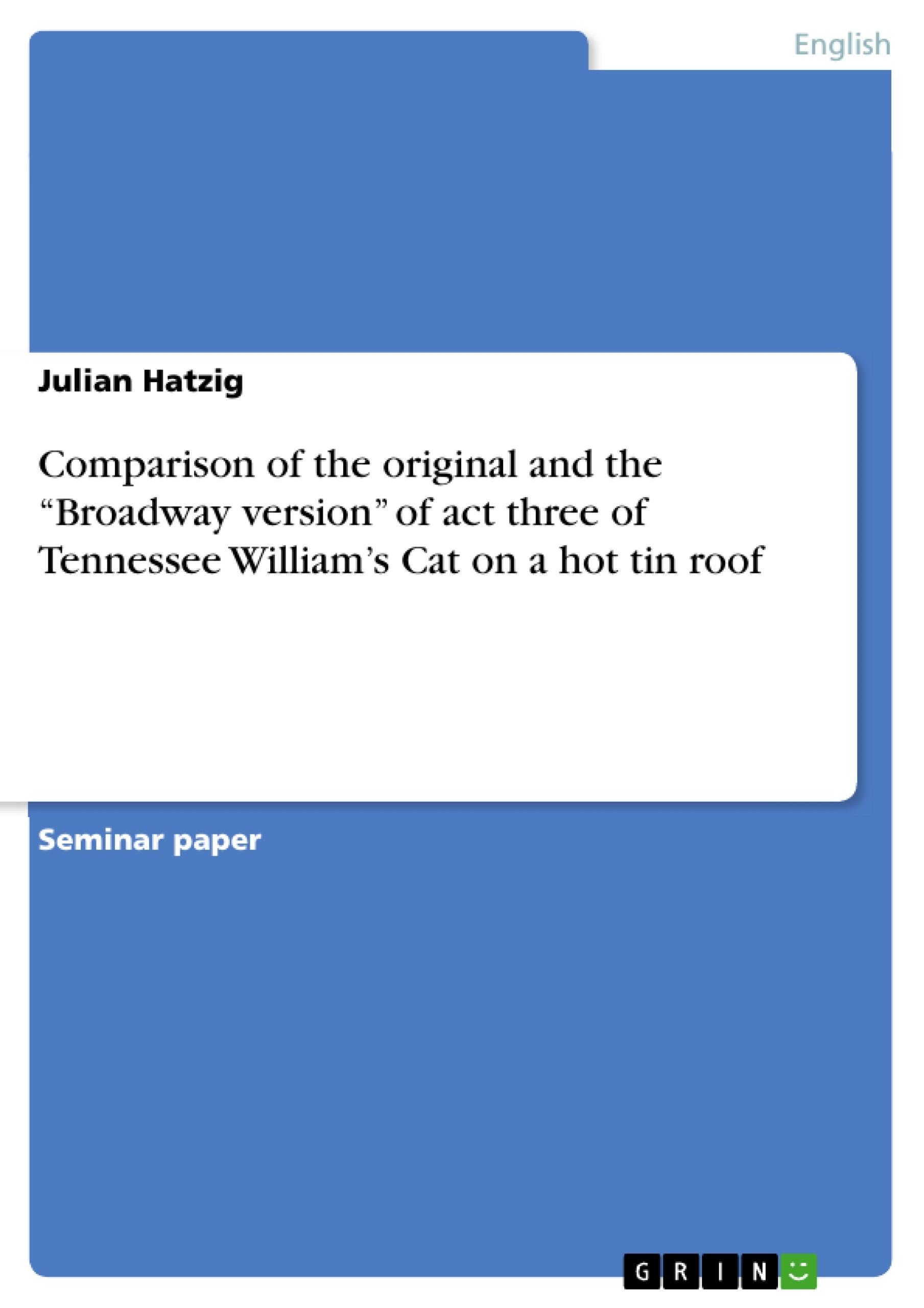The play Cat on a hot tin roof by Tennessee Williams is one of the most popular plays in the history of the American theatre. “That play comes closest to being both a work of art and a work of craft,” Williams wrote in his Memoirs. It is fact that Tennessee Williams liked “Cat on a hot tin roof” a little bit more than his other plays. He liked it even more than “A streetcar named desire” which is often referred to as his best and most famous play. You can argue about statement, Cat on a hot tin roof being his best work, but you will not be able to argue the success, the play had, away. First played on March 24, 1955 Cat on a hot tin roof won the Pulitzer Price as well as the New York Drama Critics Circle Award as the best American play of the season. It furthermore became Williams’s longest running show ever with 692 performances. What I will be dealing with subsequently is the most interesting aspect of the plays Broadway version. To be more precisely my topic will be the third act of the play, which is different compared to the original version.
First I will give a brief summary of the original version of the third act. This will be followed by the naming of the similarities and the biggest differences between the two versions. Then, it is very important in my opinion to close, answering some upcoming questions about the two versions of act three. “Who had the idea to change the third act for the performance on Broadway?” and “Why did the changes take place and what were the ideas behind them?” I think with the help of my described approach I can cope with the task to compare the original and the Broadway version of Tennessee Williams Cat on a hot tin roof.
Inhaltsverzeichnis (Table of Contents)
- I. Introduction
- II. Summary - Original 3rd Act
- III. Comparison and Analysis
- IV. Background Information
Zielsetzung und Themenschwerpunkte (Objectives and Key Themes)
This preview examines the third act of Tennessee Williams’ “Cat on a Hot Tin Roof”, specifically comparing the original version to the Broadway adaptation. The preview aims to outline the differences between the two versions and explore the reasoning behind the changes made for Broadway.- The differences between the original and Broadway versions of the third act
- The impact of the changes on the characters and themes of the play
- The potential reasons for the changes made to the third act for Broadway
- The significance of the third act in the overall narrative of the play
- The impact of the changes on the audience’s understanding of the play
Zusammenfassung der Kapitel (Chapter Summaries)
I. Introduction
This chapter introduces the play "Cat on a Hot Tin Roof" by Tennessee Williams and highlights its popularity in American theatre. It also mentions that Williams preferred this play over his other works, including "A Streetcar Named Desire", and discusses the play's success in terms of awards and its long run on Broadway.II. Summary - Original 3rd Act
This chapter provides a detailed summary of the original third act of the play, focusing on the emotional dialogue between Brick and his father Big Daddy, the revelation of Big Daddy's illness, and the subsequent power struggles between family members. The chapter highlights the conflicting emotions and motivations of the characters, particularly Big Mama's denial of Big Daddy's illness and Gooper's desire to take over the family business.III. Comparison and Analysis
This chapter compares and analyzes the original and Broadway versions of the third act, highlighting the key differences and their impact on the narrative. The chapter discusses the re-appearance of Big Daddy in the Broadway version, the change in Brick's behavior, and the shift in the relationship between Brick and Margaret.IV. Background Information
This chapter delves into the background information surrounding the changes made to the third act for Broadway. It explores the potential reasons for the changes, considering the perspectives of the playwright, the director, and the audience. The chapter discusses the impact of the changes on the play's overall message and the audience's understanding of the characters and their motivations.Schlüsselwörter (Keywords)
This preview focuses on the play "Cat on a Hot Tin Roof" by Tennessee Williams, exploring the differences between the original and Broadway versions of the third act. Key terms include "original version," "Broadway adaptation," "third act," "character development," "narrative structure," and "audience reception." The preview analyzes the impact of the changes made to the third act on the play's themes of family dynamics, deception, and the human condition.- Quote paper
- Julian Hatzig (Author), 2010, Comparison of the original and the “Broadway version” of act three of Tennessee William’s Cat on a hot tin roof , Munich, GRIN Verlag, https://www.grin.com/document/211693




